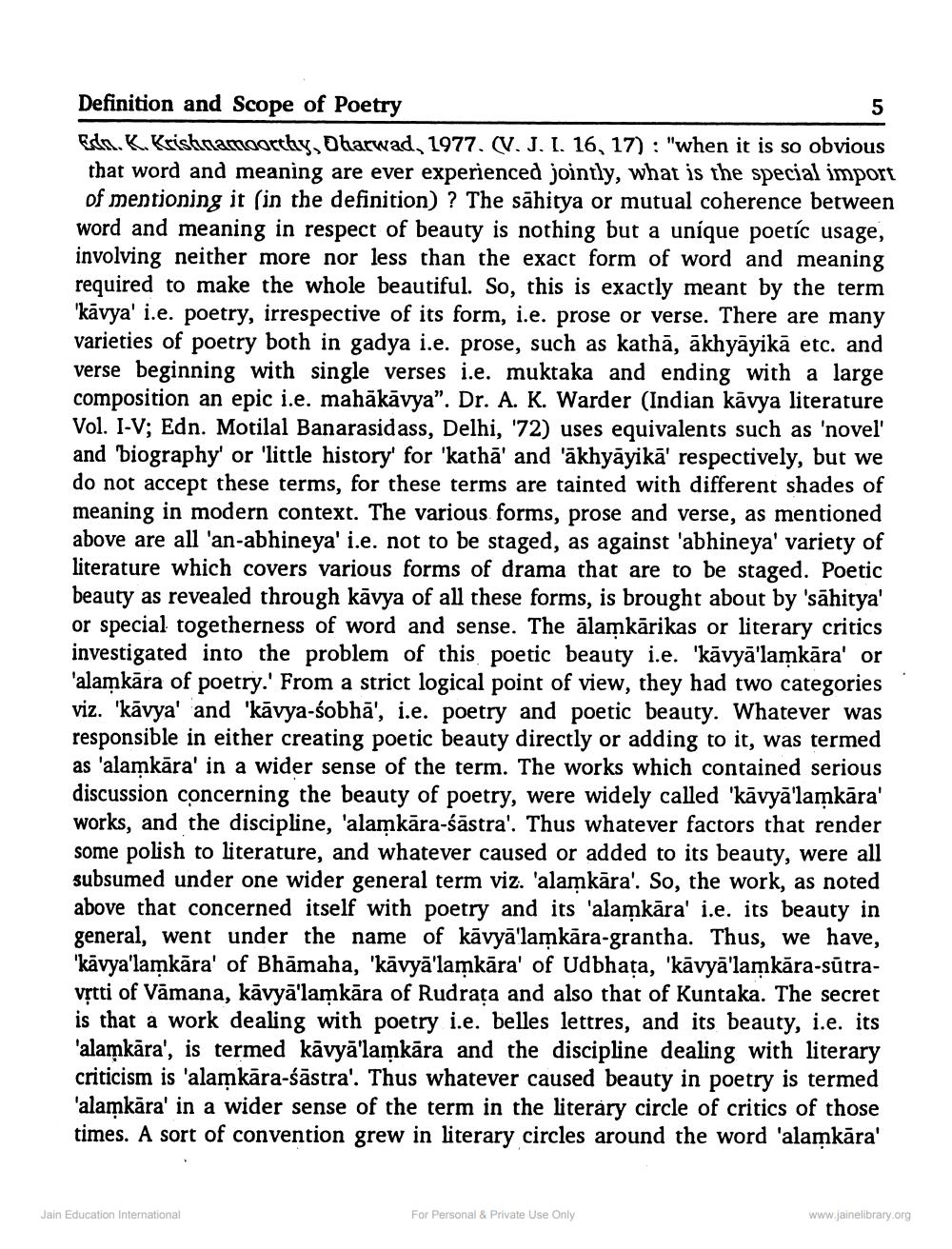________________
Definition and Scope of Poetry
Eda. K. Krishnamoorthy, Dharwad, 1977. (V. J. I. 16, 17): "when it is so obvious that word and meaning are ever experienced jointly, what is the special import of mentioning it (in the definition) ? The sahitya or mutual coherence between word and meaning in respect of beauty is nothing but a unique poetic usage, involving neither more nor less than the exact form of word and meaning required to make the whole beautiful. So, this is exactly meant by the term 'kavya' i.e. poetry, irrespective of its form, i.e. prose or verse. There are many varieties of poetry both in gadya i.e. prose, such as kathā, ākhyāyikā etc. and verse beginning with single verses i.e. muktaka and ending with a large composition an epic i.e. mahākāvya". Dr. A. K. Warder (Indian kävya literature Vol. I-V; Edn. Motilal Banarasidass, Delhi, '72) uses equivalents such as 'novel' and biography' or 'little history' for 'kathā' and 'ākhyāyikā' respectively, but we do not accept these terms, for these terms are tainted with different shades of meaning in modern context. The various forms, prose and verse, as mentioned above are all 'an-abhineya' i.e. not to be staged, as against 'abhineya' variety of literature which covers various forms of drama that are to be staged. Poetic beauty as revealed through kāvya of all these forms, is brought about by 'sāhitya' or special togetherness of word and sense. The ālamkārikas or literary critics investigated into the problem of this poetic beauty i.e. 'kāvyā'lamkāra' or 'alamkāra of poetry.' From a strict logical point of view, they had two categories viz. 'kāvya' and 'kāvya-sobhā', i.e. poetry and poetic beauty. Whatever was responsible in either creating poetic beauty directly or adding to it, was termed as 'alamkāra' in a wider sense of the term. The works which containe discussion concerning the beauty of poetry, were widely called 'kāvyā'lamkāra' works, and the discipline, 'alamkāra-śāstra'. Thus whatever factors that render some polish to literature, and whatever caused or added to its beauty, were all subsumed under one wider general term viz. 'alamkāra'. So, the work, as noted above that concerned itself with poetry and its 'alamkāra' i.e. its beauty in general, went under the name of kāvyā'lamkāra-grantha. Thus, we have, "kāvya'lamkāra' of Bhāmaha, 'kāvyā'lamkāra' of Udbhata, 'kāvyā'lamkāra-sūtravrtti of Vāmana, kāvyā'lamkāra of Rudrata and also that of Kuntaka. The secret is that a work dealing with poetry i.e. belles lettres, and its beauty, i.e. its 'alamkāra', is termed kāvyā'lamkāra and the discipline dealing with literary criticism is 'alamkāra-śāstra'. Thus whatever caused beauty in poetry is termed 'alamkāra' in a wider sense of the term in the literary circle of critics of those times. A sort of convention grew in literary circles around the word 'alamkāra'
Jain Education International
For Personal & Private Use Only
www.jainelibrary.org




